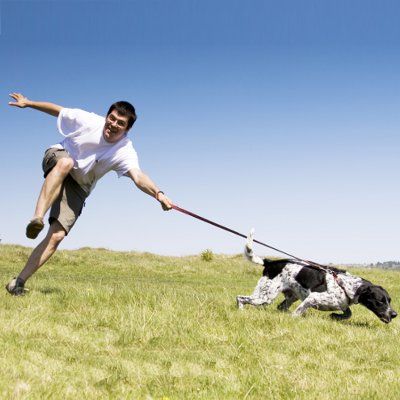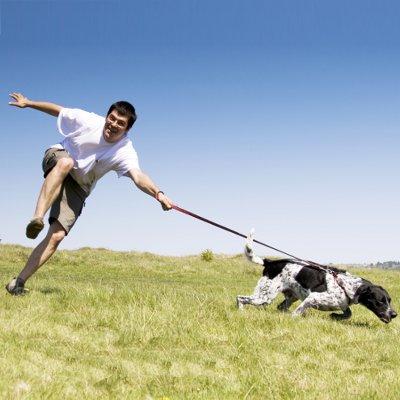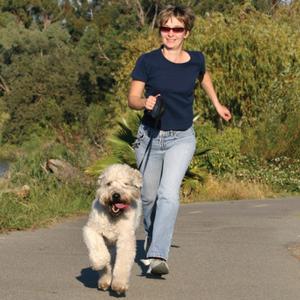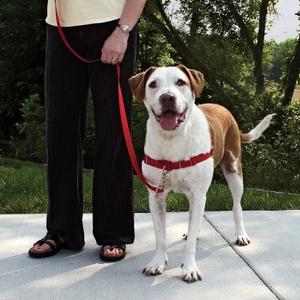February 22nd is Walking the Dog Day. Many people love taking their dogs on adventures near and far, but what are the chances you could be pushing your dog too hard? We're going to be talking about which dogs might be better suited for outdoor adventures, how to best be prepared for taking your dog on outdoor walks, and some warning signs that your dog might be getting too tired.
We're going to start out by talking about what walking is and how to do it safely. We'll be talking about walking only. Running will be in a separate article.
Why is walking good for dogs?

Walking is a good cardiovascular exercise and also keeps the "juices flowing" in your dog's muscles and joints. It provides mental exercise since he smells new smells, hears new sounds, and sees new things.
First, let's define what a walk is: The dictionary defines walking as moving "at a regular pace by lifting and setting down each foot in turn, never having both feet off the ground at once" for people and two feet off the ground for our dogs. For me, a walk is on leash where the dog walks at my pace (not a quick potty break), so that's what we're going to be talking about here.
How to best be prepared for taking your dog on outdoor walks
There are several factors to take into consideration to make your walks safe for both you and your dog:
- Your dog's age
- Puppies - Sleep most of the day because growing is hard work! Generally walks should be 5 minutes for every month of a puppy's age until he is an adult.
- Adults - A minimum of 30 minutes/day
- Seniors - May have arthritis or other age-related medical issues and may benefit from multiple shorter walks
- Your dog's breed. Each breed was bred for a different purpose, and some have greater exercise needs than others - herding, working, and sporting breeds generally need more exercise than companion or guard dogs. If you have a mixed breed, cue off of the most predominant breed in the mix.
- His anatomy - Brachycephalic dogs (those with smashed-in faces such as pugs) have shorter nasal passages and can become exhausted or short of breath much quicker than those dolichocephalic breeds (those with long nasal passages such as Afghans) or mesocephalic breeds (intermediate nasal passages such as Labradors).
- His size - Small dogs walk faster and can get tired quicker than larger dogs.
- His health and weight - Always get your veterinarian's approval before beginning an exercise program, especially if he is in pain or is recovering from an injury or operation or for overweight dogs. Yes, they do need to exercise, but it needs to be gradual.
- The weather - Avoid extremely hot or extreme cold days.
- The time of day - Avoid sunshine on hot days. Early morning, late afternoon or evening is best. Walk during sunshine on cold days, especially the middle of the day.
- The surface you're walking on - Natural surfaces such as grass and dirt are best. Asphalt and cement are okay depending on the ground temperature.
- The area you're walking in - Walk in a safe area of your community. If you're walking at night, be sure it is well lit both for your personal safety and so you can see uneven sidewalks or those with debris on them.
- Length of the walk - Don't overdo it. That brings us to the next topic.

Some warning signs that your dog might be getting too tired
- Slowing down and getting more sluggish
- Seeking shade, especially on a hot day when he is walking on hot pavement which can burn their pads
- Laying down
- Limping
- Licking their pads
- Tongue hanging out or searching for water - don't let him drink a lot, especially those dogs who have a high tuck-up such as Dobermans and are prone to bloat.
- Look for anything that is out of character for your particular dog.

Other Tips
- If you're beginning a walking program, start slowly build up your dog's tolerance for exercise.
- Take lots of breaks. Your dog will probably start sniffing, which is a physical break but not a mental one.
- If you live in a hilly area or even one with a slight incline, walk uphill at the beginning of the walk and downhill towards the end.
- In summer, avoid any areas that have foxtails which can easily get caught in between his toes, be inhaled, or work their way into other orifices such as the anus and ears.
- Avoid picture-perfect green lawns because those lawns may have been sprayed with chemicals or fertilizers that can be absorbed through your dog's feet or inhaled and can cause irritation and even epileptic seizures.
- If you take your dog with you on errands where you walk, remember not to tie him up in front of a store because he can easily get stolen.
Even with all these admonitions, you and your dog can still have fun!






